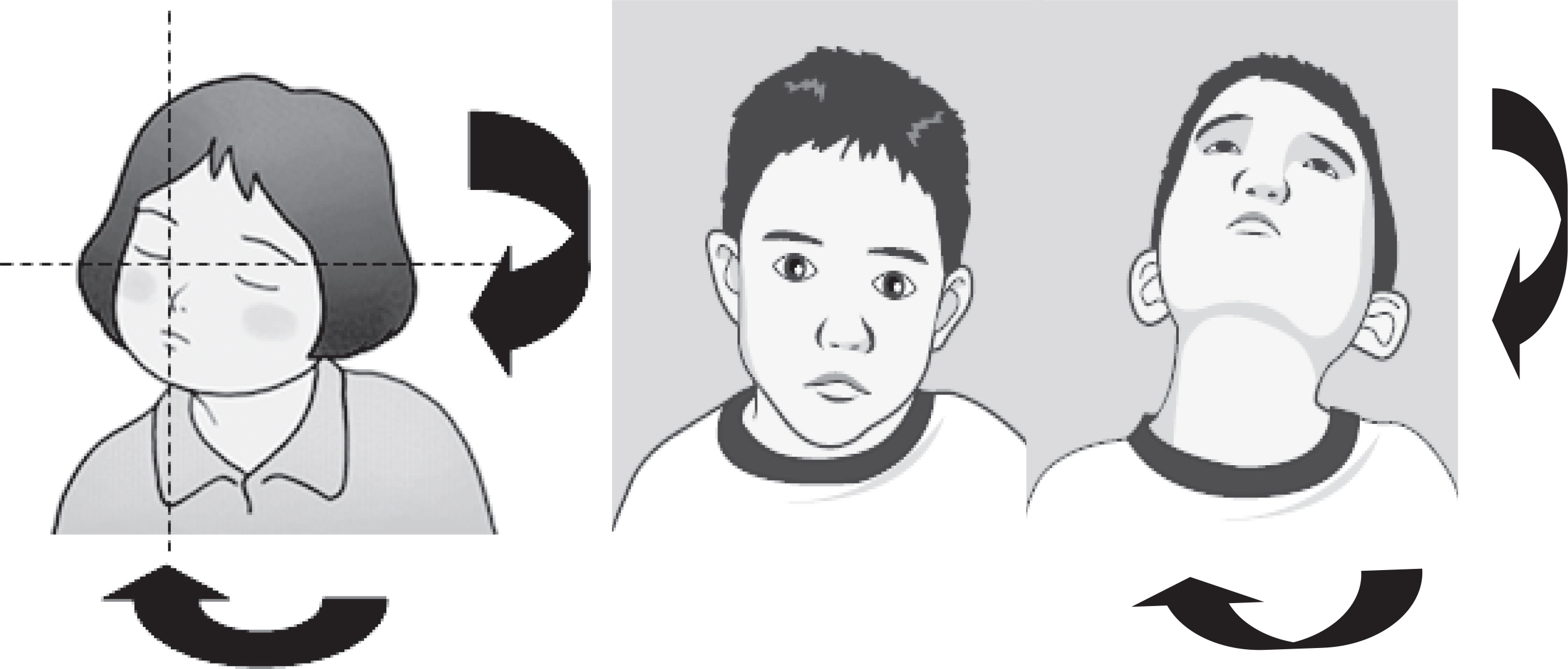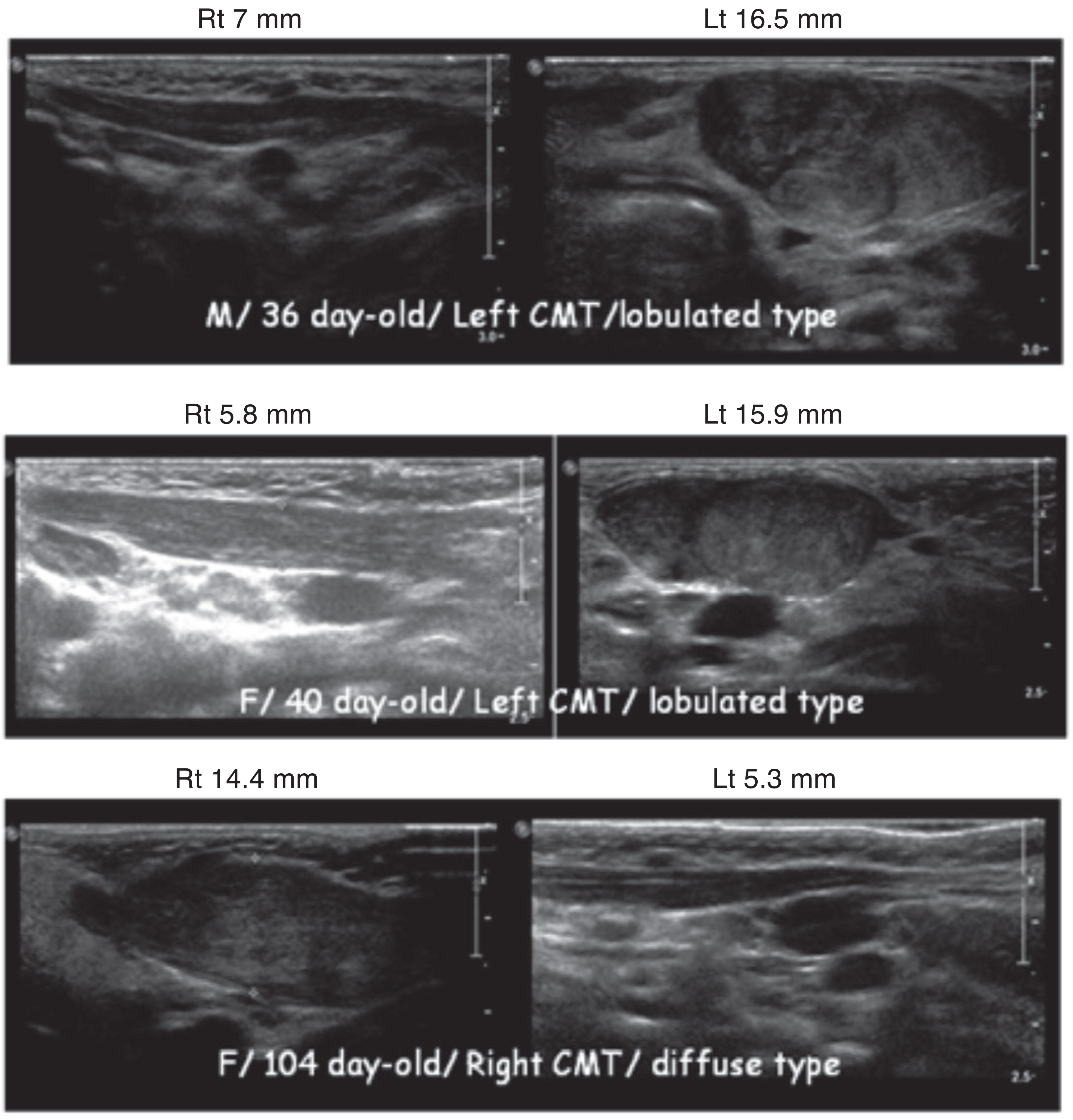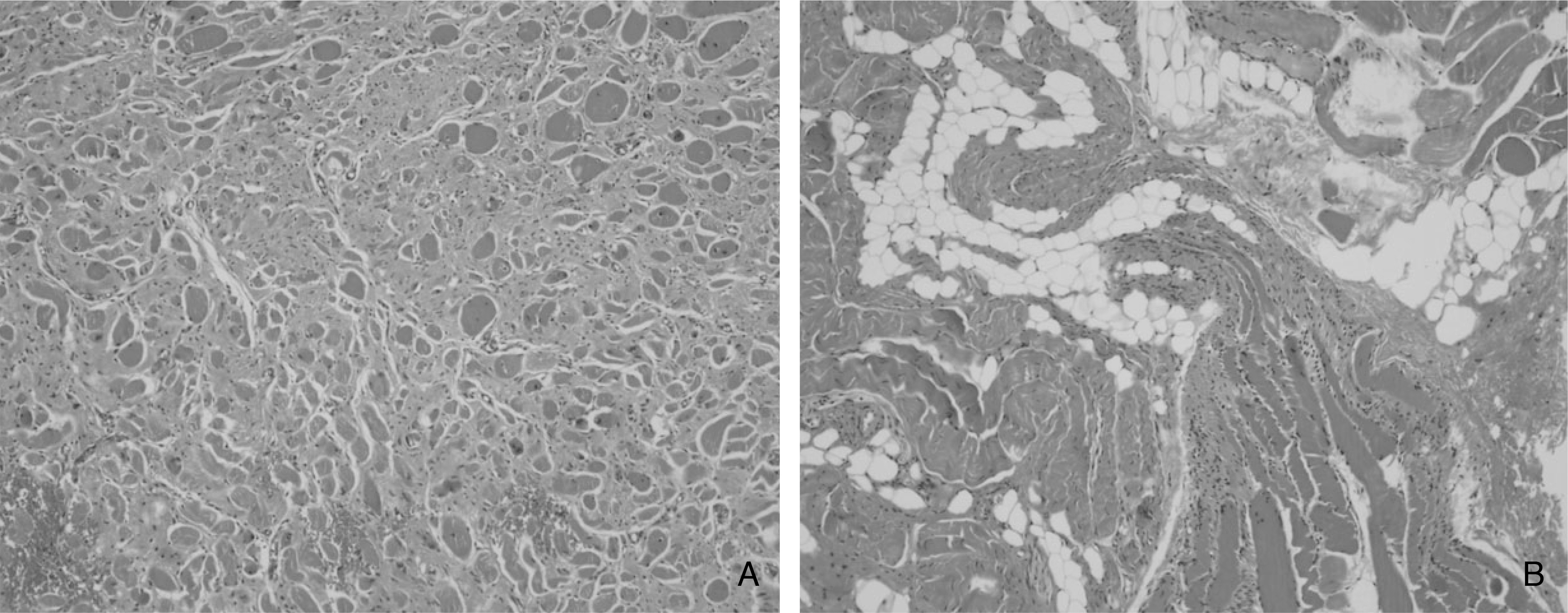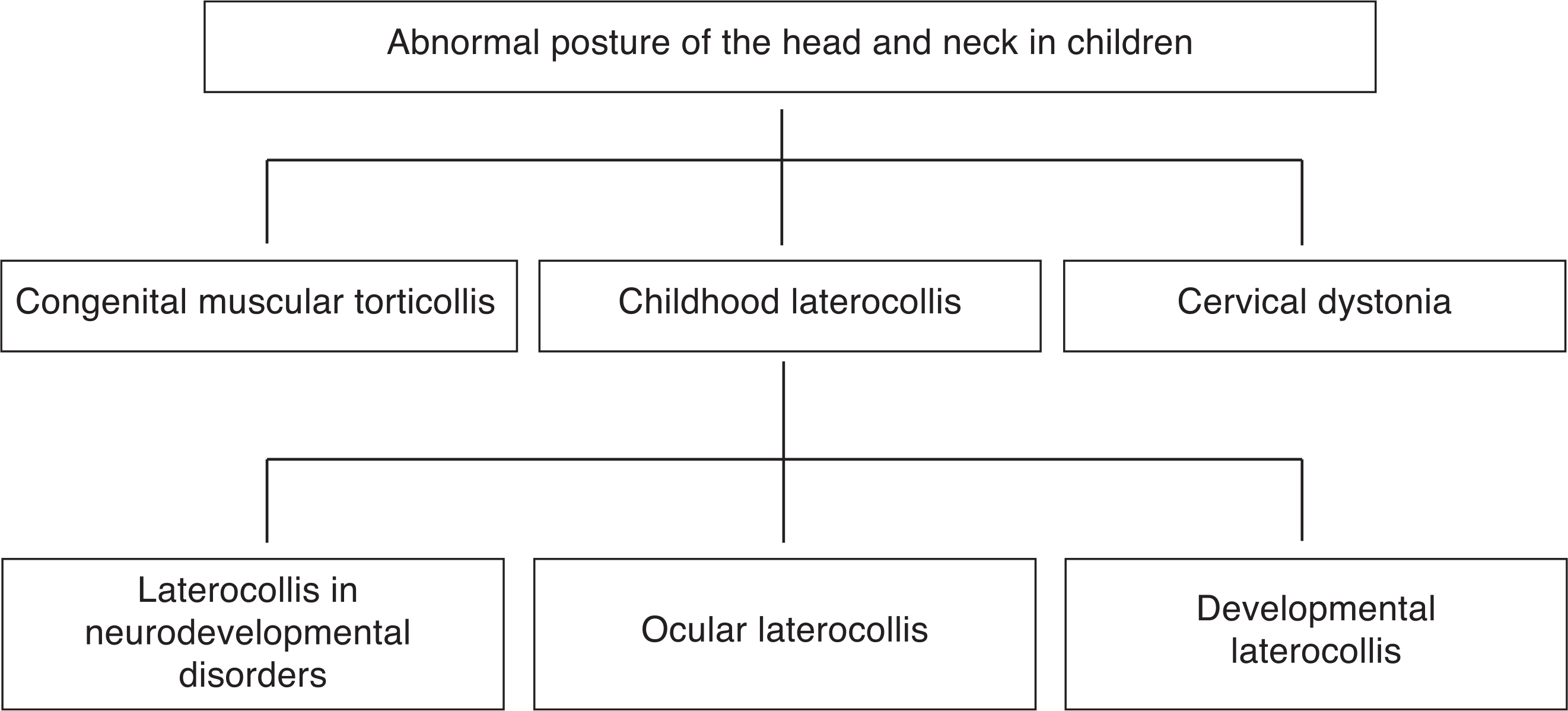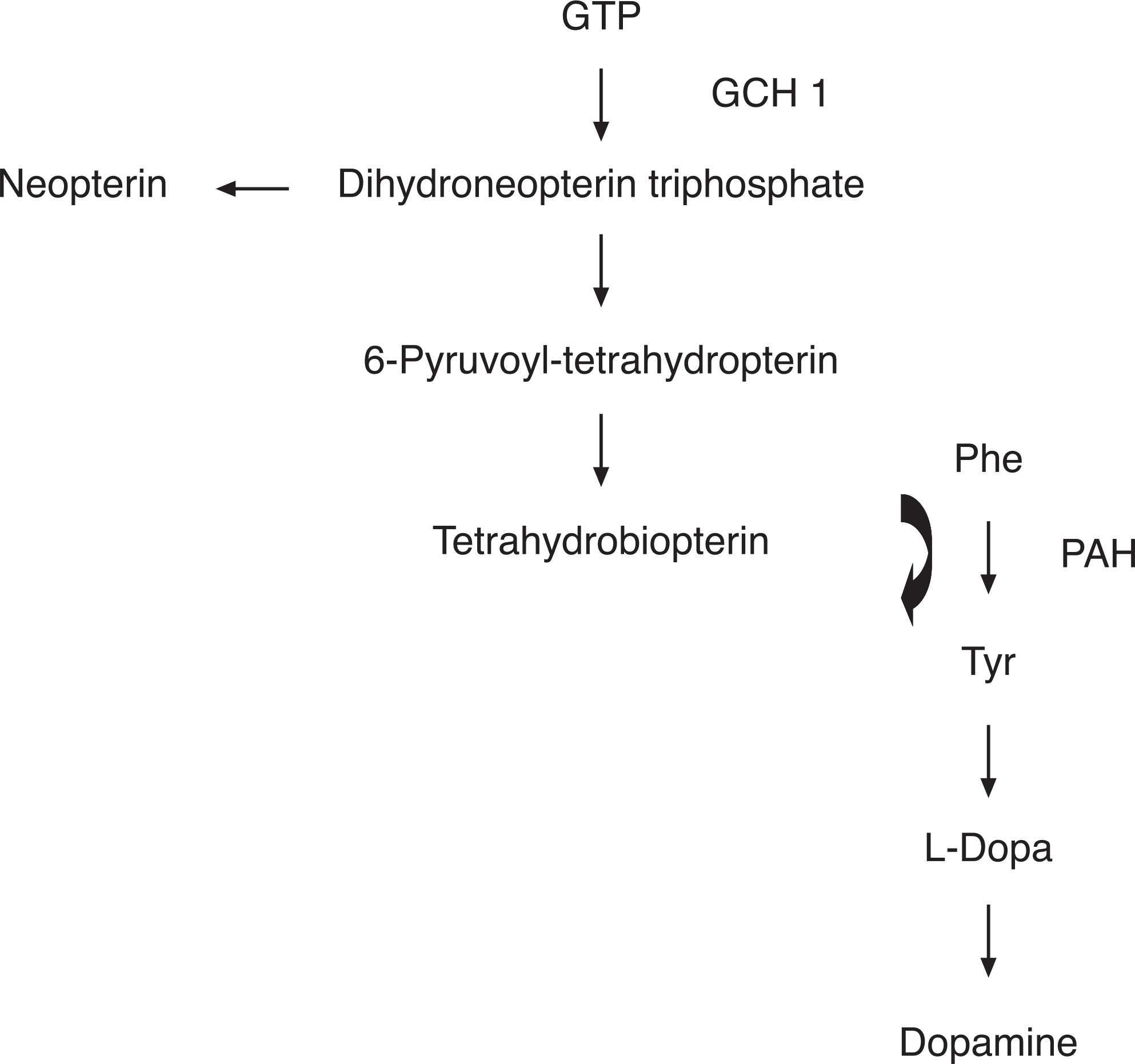Differential Diagnosis and Management of Abnormal Posture of the Head and Neck
- Affiliations
-
- 1Department of Physical Medicine and Rehabilitation/Ajou Torticollis Clinic, Ajou University School of Medicine, Korea. syyim@ajou.ac.kr, iylee@ajou.ac.kr
- 2Department of Plastic and Reconstructive Surgery/Ajou Torticollis Clinic, Ajou University School of Medicine, Korea. mpark@ajou.ac.kr
- 3Department of Pathology/Ajou Torticollis Clinic, Ajou University School of Medicine, Korea. mrkjhk@yahoo.co.kr
- KMID: 2188031
- DOI: http://doi.org/10.5124/jkma.2009.52.7.705
Abstract
- Abnormal posture of the head and neck can happen to anybody from neonates to adults, which requires appropriate interventions according to etiologies. Congenital muscular torticollis is the most common cause of abnormal posture of the head and neck in infancy, where early intervention as soon as possible is critical for better therapeutic outcome. Childhood laterocollis is heterogeneous condition, which needs etiological diagnosis for the proper management. Cervical dystonia is the most common form of focal dystonia and an overview on clinical presentations and therapeutic options including chemodenervation with botulinum toxin injection was provided. Abnormal posture of the head and neck of acute onset could be a sign of serious conditions and needs differential diagnosis.
Keyword
MeSH Terms
Figure
Cited by 6 articles
-
The Thickness of the Sternocleidomastoid Muscle as a Prognostic Factor for Congenital Muscular Torticollis
Jae Deok Han, Seung Hwan Kim, Seung Jae Lee, Myong Chul Park, Shin-Young Yim
Ann Rehabil Med. 2011;35(3):361-368. doi: 10.5535/arm.2011.35.3.361.Comparison of Clinical Severity of Congenital Muscular Torticollis Based on the Method of Child Birth
Seung Jae Lee, Jae Deok Han, Han Byul Lee, Jee Hyun Hwang, Se Yon Kim, Myong Chul Park, Shin-Young Yim
Ann Rehabil Med. 2011;35(5):641-647. doi: 10.5535/arm.2011.35.5.641.Magnetic Resonance Imaging as a Determinant for Surgical Release of Congenital Muscular Torticollis: Correlation with the Histopathologic Findings
Jee Hyun Hwang, Han Byul Lee, Jang-Hee Kim, Myong Chul Park, Kyu-Sung Kwack, Jae Deok Han, Shin-Young Yim
Ann Rehabil Med. 2012;36(3):320-327. doi: 10.5535/arm.2012.36.3.320.Threshold of Clinical Severity of Cervical Dystonia for Positive 18F-FDG PET/CT
Hyun Jung Lee, Young-Sil An, Young-Whan Ahn, Shin-Young Yim
Ann Rehabil Med. 2013;37(6):777-784. doi: 10.5535/arm.2013.37.6.777.Clinical Usefulness of Sonoelastography in Infants With Congenital Muscular Torticollis
Seong Kyung Hong, Jin Won Song, Seung Beom Woo, Jong Min Kim, Tae Eun Kim, Zee Ihn Lee
Ann Rehabil Med. 2016;40(1):28-33. doi: 10.5535/arm.2016.40.1.28.Effectiveness of Surgical Release in Patients With Neglected Congenital Muscular Torticollis According to Age at the Time of Surgery
Kyung-Jay Min, Ah-Reum Ahn, Eun-Ji Park, Shin-Young Yim
Ann Rehabil Med. 2016;40(1):34-42. doi: 10.5535/arm.2016.40.1.34.
Reference
-
References
1. Cheng JC, Metreweli C, Chen TM, Tang S. Correlation of ultrasonographic imaging of congenital muscular torticollis with clinical assessment in infants. Ultrasound Med Biol. 2000; 26:1237–1241.
Article2. Cheng JC, Tang SP, Chen TM, Wong MW, Wong EM. The clinical presentation and outcome of treatment of congenital muscular torticollis in infants-a study of 1,086 cases. J Pediatr Surg. 2000; 35:1091–1096.
Article3. Chen MM, Chang HC, Hsieh CF, Yen MF, Chen TH. Predictive model for congenital muscular torticollis: analysis of 1021 infants with sonography. Arch Phys Med Rehabil. 2005; 86:2199–2203.
Article4. Dudkiewicz I, Ganel A, Blankstein A. Congenital muscular torticollis in infants: ultrasound-assisted diagnosis and evaluation. J Pediatr Orthop. 2005; 25:812–814.
Article5. Sonmez K, Turkyilmaz Z, Demirogullari B, Ozen IO, Karabulut R, Bagbanci B, Basaklar AC, Kale N. Congenital muscular torticollis in children. ORL J Otorhinolaryngol Relat Spec. 2005; 67:344–347.6. Do TT. Congenital muscular torticollis: current concepts and review of treatment. Curr Opin Pediatr. 2006; 18:26–29.7. Tatli B, Aydinli N, Caliskan M, Ozmen M, Bilir F, Acar G. Congenital muscular torticollis: evaluation and classification. Pediatr Neurol. 2006; 34:41–44.8. Cheng JC, Au AW. Infantile torticollis: a review of 624 cases. J Pediatr Orthop. 1994; 14:802–808.9. Cheng JC, Tang SP, Chen TM. Sternocleidomastoid pseudotumor and congenital muscular torticollis in infants: a prospective study of 510 cases. J Pediatr. 1999; 134:712–716.
Article10. Friedman M, LoSavio P, Ibrahim H. Superior laryngeal nerve identification and preservation in thyroidectomy. Arch Otolaryngol Head Neck Surg. 2002; 128:296–303.
Article11. Kiray A, Naderi S, Ergur I, Korman E. Surgical anatomy of the internal branch of the superior laryngeal nerve. Eur Spine J. 2006; 15:1320–1325.
Article12. Reynolds SM, Mackenzie AJ, Spina D, Page CP. The pharmacology of cough. Trends Pharmacol Sci. 2004; 25:569–576.
Article13. Thompson F, McManus S, Colville J. Familial congenital muscular torticollis: case report and review of the literature. Clin Orthop Relat Res. 1986. 193–196.14. Davids JR, Wenger DR, Mubarak SJ. Congenital muscular torticollis: sequela of intrauterine or perinatal compartment syndrome. J Pediatr Orthop. 1993; 13:141–147.15. Yu CC, Wong FH, Lo LJ, Chen YR. Craniofacial deformity in patients with uncorrected congenital muscular torticollis: an assessment from three-dimensional computed tomography imaging. Plast Reconstr Surg. 2004; 113:24–33.
Article16. Park MC, Song HS, Kim CS, Yim SY, Park DH, Pae NS, Lee IJ. Treatment of congenital muscular torticollis with unipolar release. J Korean Soc Plast Reconstr Surg. 2009; 35:38–45.17. Oleszek JL, Chang N, Apkon SD, Wilson PE. Botulinum toxin type a in the treatment of children with congenital muscular torticollis. Am J Phys Med Rehabil. 2005; 84:813–816.
Article18. Collins A, Jankovic J. Botulinum toxin injection for congenital muscular torticollis presenting in children and adults. Neurology. 2006; 67:1083–1085.
Article19. Singh A, Wacogne I. What is the role of helmet therapy in positional plagiocephaly? Arch Dis Child. 2008; 93:807–809.
Article20. Lee RP, Teichgraeber JF, Baumgartner JE, Waller AL, English JD, Lasky RE, Miller CC, Gateno J, Xia JJ. Long-term treatment effectiveness of molding helmet therapy in the correction of posterior deformational plagiocephaly: a five-year follow-up. Cleft Palate Craniofac J. 2008; 45:240–245.
Article21. Raman S, Takhtani D, Wallace EC. Congenital torticollis caused by unilateral absence of the sternocleidomastoid muscle. Pediatr Radiol. 2009; 39:77–79.
Article22. Williams CR, O'Flynn E, Clarke NM, Morris RJ. Torticollis secondary to ocular pathology. J Bone Joint Surg Br. 1996; 78:620–624.
Article23. Madigan WP, Zein WM. Recent developments in the field of superior oblique palsies. Curr Opin Ophthalmol. 2008; 19:379–383.
Article24. Quartarone A, Rizzo V, Morgante F. Clinical features of dystonia: a pathophysiological revisitation. Curr Opin Neurol. 2008; 21:484–490.
Article25. Benecke R, Dressler D. Botulinum toxin treatment of axial and cervical dystonia. Disabil Rehabil. 2007; 29:1769–1777.
Article26. Stacy M. Epidemiology, clinical presentation, and diagnosis of cervical dystonia. Neurol Clin. 2008; 26(Suppl 1):23–42.27. Jankovic J, Tsui J, Bergeron C. Prevalence of cervical dystonia and spasmodic torticollis in the United States general population. Parkinsonism Relat Disord. 2007; 13:411–416.
Article28. Lee CS, Lee CS, Chung SJ, Chung SJ, Im JH, Im JH, Lee MC, Lee MC, Yoo HW, Yoo HW. The DYT1 Gene Mutation in Primary Torsion Dystonia without Familial Background. J Korean Neurol Assoc. 2003; 21:169–173.29. Nishiyama N, Yukishita S, Hagiwara H, Kakimoto S, Nomura Y, Segawa M. Gene mutation in hereditary progressive dystonia with marked diurnal fluctuation (HPD), strictly defined dopa-responsive dystonia. Brain Dev. 2000; 22(Suppl 1):S102–106.
Article30. Adam OR, Jankovic J. Treatment of dystonia. Parkinsonism Relat Disord. 2007; 13(Suppl 3):S362–368.
Article31. Jankovic J. Treatment of dystonia. Lancet Neurol. 2006; 5:864–872.
Article32. Ranoux D. Cervical dystonia. In: Ranoux D, Gury C, eds. Practical handbook on botulinum toxin. Marseile, France: 33. Agrawal A, Cincu R, Joharapurkar SR, Bhake A, Hiwale KM. Hemorrhage in brain stem cavernoma presenting with torticollis. Pediatr Neurosurg. 2009; 45:49–52.34. Hicazi A, Acaroglu E, Alanay A, Yazici M, Surat A. Atlantoaxial rotatory fixation-subluxation revisited: a computed tomographic analysis of acute torticollis in pediatric patients. Spine. 2002; 27:2771–2775.35. Maigne JY, Mutschler C, Doursounian L. Acute torticollis in an adolescent: case report and MRI study. Spine. 2003; 28:E13–15.36. Simsek S, Yigitkanli K, Kazanci A, Belen D, Bavbek M. Medically treated paravertebral Brucella abscess presenting with acute torticollis: case report. Surg Neurol. 2007; 67:207–210.
Article37. Sankar J, Srinivasan A, Ramakrishnan V, Balasubramaniam C. An Unusual Cause of Acute Torticollis. Clin Pediatr (Phila). 2009.
Article38. Papadimitriou NG, Christophoridis J, Papadimitriou A, Beslikas TA. Acute torticollis after isolated stress fracture of the first rib in a child. A case report. J Bone Joint Surg Am. 2005; 87:2537–2540.
Article39. Mukherjee S, Sharief N. Bacterial meningitis presenting as acute torticollis. Acta Paediatr. 2004; 93:1005–1006.
Article
- Full Text Links
- Actions
-
Cited
- CITED
-
- Close
- Share
- Similar articles
-
- Surgery for Vertical Abnormal Head Posture in Infantile Nystagmus
- The Influence of the Head Posture on the Motor Alignment and Sensory Status in the Patients with the Abnormal Head Posture
- The Effect of Forward Head Posture and Tension Type Headache on Neck Movement: For Office Worker
- Clinical Characteristics of Abnormal Postures of the Head and Neck Caused by Unilateral Superior Oblique Palsy
- The role of the neck on the control of body posture in bilateral labyrinthectomized rabbits



